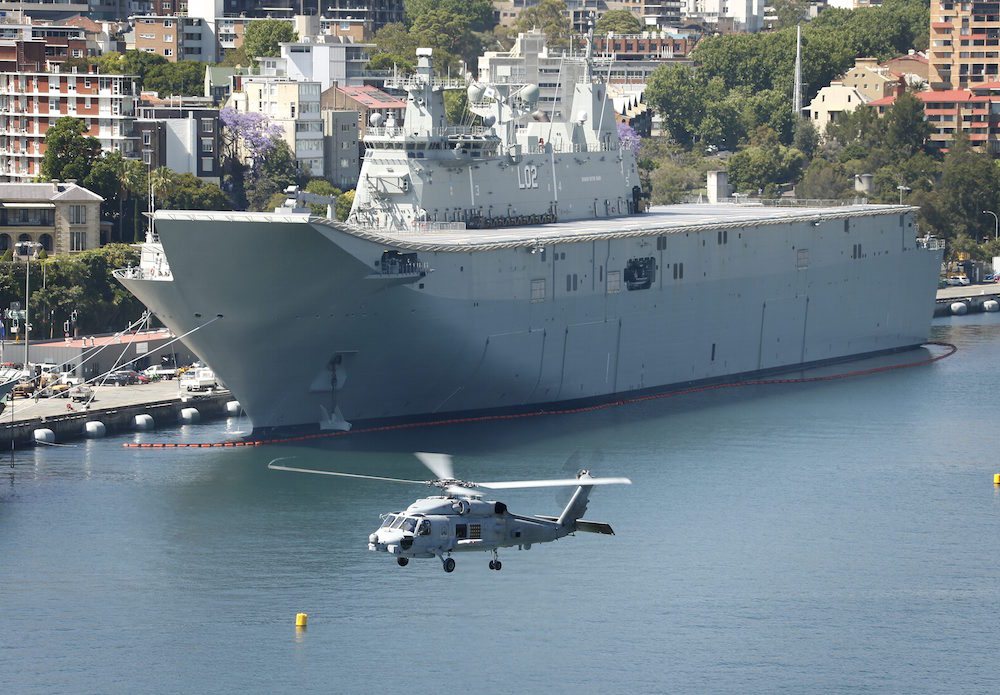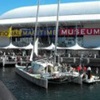
Last Friday saw the commissioning of the Royal Australian Navy’s newest and largest fleet member – the Landing Helicopter Dock (or LHD for short) HMAS Canberra (III).
In a short space of time and in century-old tradition, she went from being Nuship Canberra to raising the Australian white ensign for the first time as part of her formal commissioning into the Fleet.

The Royal Australian Navy’s latest helicopter, the MH60R ‘Romeo’ Seahawk, flies past the Navy’s latest ship, NUSHIP Canberra in Sydney, NSW. Courtesy Royal Australian Navy.
It was a significant moment for all those associated with the building and fitting out of the LHD, especially the tri-service ship’s company who have been training for months in preparation for the introduction of the LHD. Navy, Air Force and Army come together to operate this ship.
As well as raising the white ensign another tradition was also observed, that of the youngest member of Canberra’s ship’s company (Seaman Marine Technician Michael Lane) cutting the commissioning cake alongside Canberra’s Commanding Officer (Captain Jonathan Sadleir AM, RAN).

LS Stewart Thurlow raises the Australian white ensign for the first time on board the newly commissioned HMAS Canberra. Courtesy Royal Australian Navy.
In the life of a naval ship there are many ceremonial milestones including ship naming, keel laying, christening, commissioning and final decommissioning. The commissioning ceremony completes the cycle from christening and launching to bring the ship into full status as a warship of her nation.
Canberra carries a proud name indeed. The first Canberra was a heavy cruiser sunk in action at the Battle of Savo Island in August 1942. The second Canberra was a guided missile frigate and saw service during the Gulf War; she was sunk off Ocean Grove, Victoria as an artificial reef and dive wreck. In line with naval tradition, Canberra (III) inherits the battle honours from the previous two ships of the same name – East Indies 1940-41, Pacific 1941-42, Guadalcanal 1942, Savo Island 1942 and Persian Gulf 2002.
So what is Canberra going to be doing for the Royal Australian Navy? She is the lead ship of the two Canberra class amphibious assault ships designed by Spanish shipbuilders Navantia. Canberra and her sister-ship Adelaide are prefabricated in Spain and then fitted out in Melbourne. They are capable of conducting large-scale humanitarian missions and will focus on regional military support, including disasters (they can be deployed as floating hospitals and command and control centres); evacuation missions (such as a raid from the sea to recover hostages); and peacekeeping. They will also play a key role in extreme natural disasters at home.

An internal cross-section of the Canberra class Amphibious Assault Ship puts in perspective her ability to carry an incredible amount of vehicles, vessels and aircraft.
There are many mindboggling and impressive statistics associated with the ship. Here are a few:
- Construction cost was $A1.5 billion;
- She’s 230 metres long, the flight deck is eight stories above the water and as big as 24 tennis courts;
- Canberra could sail under the Sydney Harbour Bridge – with 40 cm to spare!
- She can embark 1,100 fully-equipped infantry troops and 110 trucks and armoured vehicles;
- She can carry 18 helicopters (six can operate simultaneously from landing points on the flight deck);
- Elevators and ramps are used to move vehicles, aircraft and personnel around the ship;
- Cooks can prepare up to 6,000 meals daily;
- There are two operating theatres and 56 hospital beds, an eight-bed critical care unit, pathology and radiology services, x-ray, pharmacy and dental facilities.
- The ship can make 150 tonnes of fresh water per day and generate enough power to power a city the size of Darwin;
- The heavy vehicle deck covers 1400 square metres;
- The ship can carry 196 shipping containers;
- The well dock holds water the equivalent of 1.2 Olympic swimming pools and has access to the open sea through the stern to allow the landing craft and other boats to sail straight in and out.
HMAS Canberra will proceed to sea in the coming weeks for a period of training and assessment for the crew. She will be home ported to Garden Island, Sydney, so take yourself down to Mrs Macquarie’s Chair and see for yourself just how impressive this new addition to the Royal Australian Navy really is.
– Lindsey Shaw, Australian National Maritime Museum Research Associate
